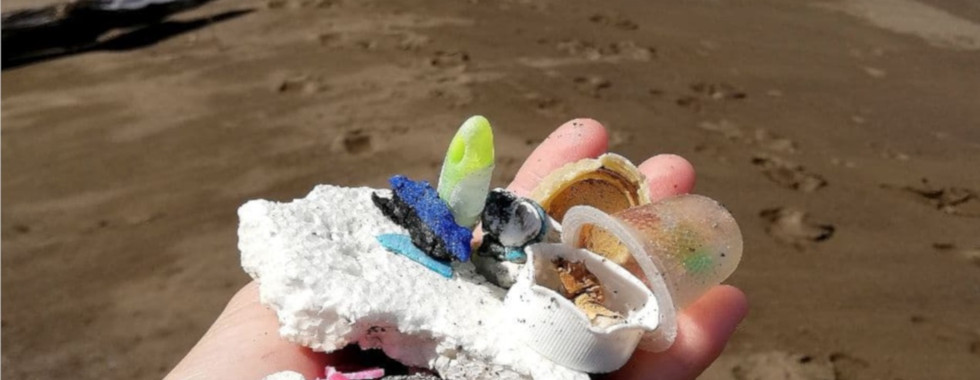"PLASTIC" Volunteer Takeover: Nik & Cat (IG @apropospopo)
- rascareycr
- Apr 8, 2021
- 7 min read
Original Post: https://apropospopo.art/2021/04/01/a-propos-plastics/
INSTAGRAM: https://www.instagram.com/apropospopo/
Plastics have an astonishing number of positive properties. They are flexible, stretchable, waterproof, very light, can be shaped in various ways, insulate, are chemically resistant, are extremely light and are available everywhere. You see them used everywhere: Packaging, bags, clothes, insulation materials, films, car body parts, shoes, bottles, fishing nets, etc. There are an incredible number of applications. Let’s just look over our groceries or look in the supermarket at all the things that are packed in plastic and think about the fact that this material has been extracted from the earth, refined and shaped at great expense of energy to serve as packaging and then thrown in the rubbish after this one-time use. A perfect, linear production and recycling process. While we in Germany, as the EU leader in the production of packaging waste, were told for years that we had a high recycling rate, it turns out that this is only about 50% (10) and that it was cheaper to export the waste to China and Malaysia to be burnt there without environmental regulations and to poison the population there (8, 9). Once again, this is a shift of problems that arise here to places where Western society hopefully does not notice. The new packaging law is supposed to counteract this and realise a recycling rate of 63% by 2022. Let’s see what the reality will look like.
The most common forms are polypropylene (PP, for packaging, films, fibres), polyethylene (PE, for packaging), polyethylene terephthalate (PET, for beverage bottles), polyvinyl chloride (for floors and pipes) and polystyrene (for insulation material, packaging, surfboards) and can be divided into thermoplastics (soften when heated) and thermosets (no longer soften when heated). Most manufacturers stamp the type of plastic somewhere on their products with the internationally uniform codes from 1 for PET to 7 for other plastics. These plastics are produced from crude oil in refineries by polymerisation (13).
Meanwhile, there are also alternatives to petroleum-based plastic. The best known is probably PLA (polylactic acid). This can be found, for example, in agriculture, in some ecologically oriented restaurants or in a few types of packaging. PLA is made from renewable raw materials and can be composted. The only question is: does it happen? Apparently PLA can only be composted properly in industrial composting plants. Organic waste has a retention time of 80 days there. However, this is not enough to compost PLA. Production should also be sustainable from a holistic point of view (14), otherwise all the substitution won’t do much good and you will have the same effect as with energy from biomass, where huge monocultures are cultivated to generate electricity or diesel admixtures (15).
As many positive properties as plastics have, we all know about their negatives. They are extremely durable and do not biodegrade. This means that as soon as they are in nature, they are broken down by movement or by the sun from large to smaller and smaller pieces. This is how macroplastics become microplastics and eventually even nanoplastics. This is then so small that it is even transported in the atmosphere (1). Therefore, even in areas of the world where there is no human influence, we find plastic residues in the soil, like in the snow in the Arctic (2). The effects on human health are not yet known.
Since its introduction in 1907 and the start of mass production in the early 1950s, plastics have spread all over the world. While in some countries there are public waste collection points and recycling systems, in many others there is insufficient recycling. The various products are carried across the country by the wind and get caught in branches, are simply dumped somewhere in valleys and finally much of it ends up in surface waters. These then eventually transport the plastics into the sea. In the sea, they get caught in the large ocean currents and collect in the huge ocean eddies that are responsible for transporting the water masses and nutrients in the oceans. So far, 5 large plastic carpets have been identified, which are located in the Indian, Pacific and Atlantic Oceans (3), but accumulations of plastic also form in small seas, such as the North Sea or the Mediterranean Sea, due to the currents (4). The one with the highest concentration of plastic particles is the Great Pacific Garbage Patch. It is located between California and Hawaii and covers 1.6 million km2, which is about 3 times the area of France (5). But not only plastic bags, bottles or shoes are found in these rubbish patches. Depending on the location, the carpet consists largely of old fishing nets, also called ghost nets. In the Baltic Sea, it is estimated that 5,000 to 10,000 pieces of net are lost every year (6) and in the Rhine alone, as the most polluted river in Europe, 191 million particles per day are transported superficially into the sea, which corresponds to an annual load of 10 tonnes (7). According to estimates, there may be more plastic than fish in the sea by 2050 (18).
But what are the problems with this? The most directly visible ones for us humans are probably the pollution of the beaches. The sea is giving us back what we have given it, so to speak. But this also happens in places where people don’t necessarily live and can collect the plastic. Instead, the plastic is mistaken for food by the animals. Recently we saw a documentary about bird populations in the Caribbean. An animal welfare project there captures the small birds and examines them for diseases before releasing them again. They have noticed that the stomachs of the young birds crunch loudly because of the plastic they are fed by their mothers. Because their stomachs are full, they have no sense of hunger and starve to death. If there are no more young animals, the population will eventually die out. But plastics are also found in all other organisms, as in a female whale washed up off Sardinia with 22 kg of plastic in its stomach (11). And what about us? It doesn’t affect us. Yes, it does, because statistically we eat about 100 pieces of plastic per meal (12). Nanoplastics can even enter our own body cells and have already been found in foetuses (16). Beautiful or?
But: „From this moment despair ends and tectics begin.“ – Bansky
The whole plastic issue is huge and extensive and unfortunately we can’t put it all into one article, otherwise you would eventually fall asleep reading it and our fingers would fall off from writing it. So what can we do?
On a personal basis, it is certainly important to be aware of the above and other aspects, to inform oneself and to talk about them. After awareness of the problem come the 3 Rs: Reduce, Reuse, Recycle. Reduce is quite simple: you don’t have to worry about the waste you don’t produce. In concrete terms, this means, for example, buying the largest possible packages for everyday products (e.g. pasta, flour, oil, etc.). You can then fill the large packages into smaller, more manageable ones at home. Or you can go shopping in one of the numerous unpackaged shops that now exist in most cities and go to the weekly market instead of the supermarket. Of course you can’t replace all packaging, but you can certainly reduce a lot. As for reuse: upcycling exists. You can find many ideas here (23). The best ideas in our opinion: Drinking bottles to refill. No more disposable plastic bottles. Cloth bags for fruit, vegetables … etc. No more disposable plastic bags. The Ecocup for menstruation, a silicone cup that replaces tampons or pads. A cup for drinks on the go, like coffee or tea, instead of paper or plastic cups.
There are also apps, such as ReplacePlastic, that allow you to scan the EAN numbers on products in the supermarket. The app then sends an email to the producer asking them to reduce.
But what about the big problems? With the big plastic carpets that are floating in the sea or in the rivers right now? What can be done there? In the meantime, many larger and smaller initiatives have been formed to tackle the problem. Recently, scientists developed a „bacterial cocktail“ that converts plastics into biomass (24). With „the Ocean CleanUP“ from Rotterdam, Everwave from Aachen or 4Ocean from the States, there are several organisations that take the stuff out of the waters, partly recycle it and also raise awareness locally. Because, to be honest, without getting to the root of the problem and fighting the cause, plastic will continue to enter the oceans. And education is the best way to do that. There are small local education programmes all over the world to educate people about plastics. Programmes that we think are great are Precious Plastics. They upload instructions on how to build plastic recycling machines and give recommendations on how to set up collection points in the communities. Or local initiatives like the one in Kenya, where plastics are recycled into building blocks (17).
To sum it all up: We have a real problem with the whole plastic flood and if we are not careful we will suffocate in it. We need to keep questioning ourselves whether we want to continue to support companies that use a lot of packaging with our purchasing decisions. What we do here in „Rascarey“ (www.rascarey.com) for example, are regular „Beach Clean Up’s“, where we spend 4 hours on the beach and collect macro- to microplastic from the beach. With the coloured caps we try to create a piece of art. But how much positive impact can this ultimately have? This is the question we ask ourselves. Sure, we set a good example and are immediately made aware of the seriousness of the problem, but unfortunately we won’t solve the problem this way. But the biggest lever, as always, is politics. Recycling must become more attractive than producing new products from petroleum. We have to move towards a real circular economy. Everything else is a waste. And every individual has the power to change that.
"It is not your fault that the world is the way it is. It would only be your fault if it stayed that way." – German band Die Ärzte
5 – L. Lebreton, B. Slat, F. Ferrari, B. Sainte-Rose, J. Aitken, R. Marthouse, S. Hajbane, S. Cunsolo, A. Schwarz, A. Levivier, K. Noble, P. Debeljak, H. Maral, R. Schoeneich-Argent, R. Brambini, J. Reisser: Evidence that the Great Pacific Garbage Patch is rapidly accumulating plastic. In: Scientific Reports. Band 8, Nr. 1, Dezember 2018, doi:10.1038/s41598-018-22939-w
16 – Ragusa et al.: Plasticenta: First evidence of microplastics in human placenta. In: Environment International, Volume 146, January 2021, doi: 10.1016/j.envint.2020.106274
20 – https://everwave.de/































link link link link link link link link link link link link link link link link link link link link link link link link link link link link link link link link link link link link link link link link link link link link link link link link link link link link link link link link link link link link link link link link link link link link link link link link link link link link link link link link link link link link link link link link link link link link link link link link link link link link link link link link link link link link link link link link link link